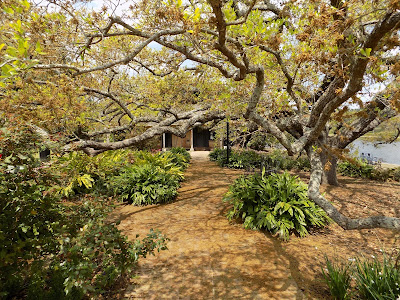There were three cities I visited which were all settled by
the French within four years of each other – Natchitoches, Louisiana (pronounced
Naketish) in 1714, Natchez, Mississippi in 1716, and New Orleans in 1718. What stands out to me is how late this part
of North America was settled. This is 100
years after the earliest North American settlements like Plymouth, St.
Augustine, and Jamestown. Even Detroit,
less than an hour away from where I grew up, was settled in 1701. I guess I’m mostly surprised because this
part of America feels older than pretty much anywhere else I’ve been in the United
States. Parts of the French quarter in
New Orleans have these ram shackle buildings, like the one below, that look
more like they should be part of the old world rather than the new.
First I’m going to talk about Natchitoches. You’ve probably never heard of this place - I
hadn’t until I was researching for my trip.
I was looking for places to stop between Dallas and New Orleans and read
about Natchitoches in an old book published by Readers Digest that I’ve owned
since I was 12 years old. The main
selling point for me of visiting this town was that it is the earliest European
settlement that was included in the Louisiana Purchase. The charm of Natchitoches is how isolated it
seems. Here are some pictures of the
downtown. It sits on the Cane River Lake
– which is a remnant of the Red river – which used to pass by the town, but
shifted to the east. The shift of the
river severely impacted the town’s trade, but it meant that the architecture of
the town has been left untouched. Here
are some pictures.
The middle picture is of an 18th century house
that is said to be of the “creole style.”
Around Natchitoches there is a strong culture of Creoles, who are a
racial mix of Spanish, French, Native American and African. The Creole culture is one of the defining
features of Louisiana. There were few
other places in the current United States where races mixed as freely as in
Louisiana. However, I don’t want to
overstate the size of their population – only 1.5% of the current Louisiana
population identifies as multiracial. Their importance lies less in their numbers
than in how they symbolize the multicultural roots of Louisiana, which is the
basis of the incredible cultural contributions that started here and eventually
spread over the planet.
Natchez is similar to Natchitoches in that it seems to be
stuck in time. It is set on a bluff
overlooking the Mississippi River.
Because of its position on the Mississippi, Natchez was an
incredibly important city from its founding through the end of the 19th
century. Signs of this importance can be
found in the city cemetery.
Although the city was founded by the French, it was
controlled by the British from 1763-1779, and then Spain from 1779-1798. The Spanish laid out the plan for the
city. The grave monument above is for
Jose Vidal, one of the Spanish grandees who served as a representative of the
Spanish crown. I was struck at the
cemetery by how many graves were of people who were born in Europe. Here are some of my favorites.
I like this one – not just because of where he was born –
but the poem that appears to be written by his wife.
“Death called
The Sculptor’s classic chisel fell
And Lyon bade his Art and Friends farewell”
This gravestone was in the Jewish section. It appears to be for two brothers who died at
only 22 and 25 years old within days of each other. It was erected by their brother Nathan. It reads:
Alas this stone too truly sadly tells
How deaths unerring relentless hand
Laid low within these narrow cells
Two pilgrims for the spirit land
Farewell my Jake and Abe farewell.
May we meet to part no more
In mansions where the blessed dwell
In the vale of the sunny shore.
Too often we seem to discount the humanity of people of the
past. We see sober paintings and photos
of the past and assume that means that people had less emotions or lived more
boring lives. Expressing oneself
emotionally – even through poetry – was actually relatively common in the 19th
century. Even in regular letters to each
other people expressed love in very emotive terms.
Another assumption that people seem to make about the past –
which is completely false – is that they were more moral than we are
today. A good example of how many people
actually acted can be found “under-the-hill” in Natchez.
“Under-the-hill” was a district for the men who plied their
trade on the river. It was filled with
gamblers, liquor, and prostitutes.
Pretty much any town along the river had similar districts. This area of the country may be religious,
but it sure isn’t puritanical.
Tomorrow the Louisiana Purchase and a founding father
behaving badly . . .











No comments:
Post a Comment